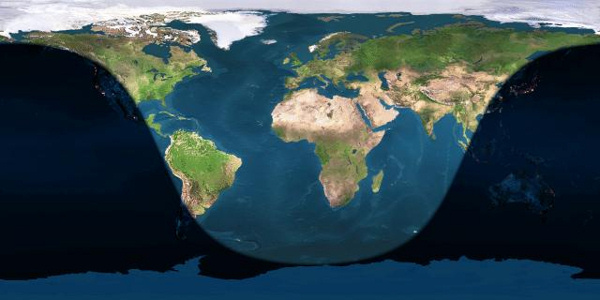Source Earth Sky


What is a supermoon?That doesn’t sound very special, does it? In fact, the June 2013 full moon lines up much more closely with perigee – the moon’s closest point to Earth – than Nolle’s original definition. According to Guy Ottewell’s Astronomical Calendar 2013, the 2013 June full moon falls only 22 minutes after the moon reaches perigee, the moon’s closest point to Earth for this month and year. At perigee, the moon lies only 356,991 kilometers (221,824 miles) away. Two weeks later, on July 7, the moon will swing out to apogee – its farthest point for the month and year – at 406,490 kilometers (252,581 miles) distant.
Full moon falls on June 23, 2013 at 11:32 UTC (6:32 a.m. CDT in the U.S.). Thus, for many, the moon appears about equally full in the June 22 sky as it does on June 23. This full moon is not only the closest and largest full moon of the year. It also presents the moon’s closest encounter with Earth for all of 2013. The moon will not be so close again until August, 2014.
At United States’ time zones, that means the moon will turn full on June 23 at 7:32 a.m. EDT, 6:32 a.m. CDT, 5:32 a.m. MDT and 4:32 a.m. PDT.
We astronomers call this sort of close full moon a perigee full moon. The word perigeedescribes the moon’s closest point to Earth for a given month. Two years ago, when the closest and largest full moon fell on March 19, 2011, many used a term we’d never heard before: supermoon. Last year, we heard this term again to describe the year’s closest full moon on May 6, 2012. Now the term supermoon is being used a lot. Last month’s full moon – May 24-25, 2013 – was also a supermoon. But the June full moon is even more super! In other words, the time of full moon falls even closer to the time of perigee, the moon’s closest point to Earth. The crest of the moon’s full phase in June 2013, and perigee, fall within an hour of each other.
 |
| Astronomers say you can’t really tell the difference in size between a supermoon and any other full moon. Check out this size comparison from our friend Alec Jones in the UK. |

The supermoon of March 19, 2011 (right), compared to an average moon of December 20, 2010 (left). Note the size difference. Image Credit: Marco Langbroek, the Netherlands, via Wikimedia Commons.
Moon closest to Earth
| Year | Date | Distance |
| 2011 | March 19 | 356,575 km |
| 2012 | May 6 | 356,955 km |
| 2013 | June 23 | 356,991 km |
| 2014 | August 10 | 356,896 km |
| 2015 | September 28 | 356,877 km |
| 2016 | November 14 | 356,509 km |
Day and night sides of Earth at instant of June 23 full moon

Day and night sides of Earth at instant of full moon (2013 June 23 at 11:32 Universal Time). In North America, the full moon is setting in the west at sunrise. From eastern Asia, it’s rising in the east at sunset. The full moon resides close tozenith – straight overhead – as seen from the Samoan islands in the central South Pacific Ocean. Image credit: Earth and Moon Viewer
